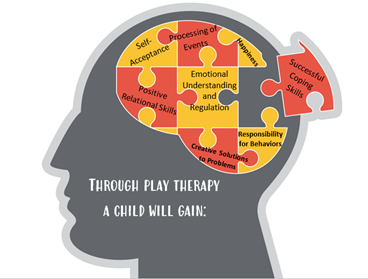Why Play Therapy?
- Kathryn Wright

- Sep 20, 2020
- 3 min read
What is Play Therapy?
Play therapy is a technique used often with children between the ages of 3 and 14. In play therapy, a therapist is trained to observe and analyze themes that are presented through a child’s play. Play is the most natural form of communication and cannot be taught. All humans are born exploring and learning their environment through play and they continue to use play, in different forms, throughout their lives to gain understanding and process their surroundings. Play therapists view play as a language and toys as words for children to articulate their thoughts, feelings, behaviors, and struggles. Depending on the developmental stage and needs of the child, play evolves and looks different. Play therapy can be adapted to meet the unique needs of the client.
Why Play Therapy Works
Play allows us to reach children in a developmentally appropriate manner. A child’s brain develops from the right to the left and from the bottom to the top. The right and bottom parts of the brain are emotional and impulsive, lacking logical and complex levels of thinking. This is the reason that children act out in behaviors, answer with “I don’t know” or “it just happened,” and have quite different perspectives of the world than adults.
Because of the differences in maturity of the brain, there is a communication gap between adults and children, almost as if we are speaking a completely different language. Children feel but cannot verbally express their feelings. They use behaviors to tell us what is wrong, and these behaviors are often misinterpreted by adults.
Due to a child’s brain not developing complex thinking and communication skills until age 11 to 14, it is not developmentally appropriate to talk through and rationally explain their thoughts, feelings, and behaviors. With play therapy we meet the child where they are developmentally and learn to speak their natural language, play.

How Play Therapy Works
Play therapists work hard to provide children with a safe and trusting environment in which they can comfortably work through their struggles without social repercussions. Specific toys are chosen for the purpose of allowing children to express themselves and are arranged in categories that invite children to use them for metaphoric communication. By providing this controlled, trusting environment, children build a relationship with the therapist that promotes emotional healing and cognitive resolution of conflicts. Children learn to freely express their problems in a language that is natural to them and they begin to address and resolve inner struggles.
Since children cannot adequately express themselves in the adult world, the therapist takes the child’s lead. Play therapists are trained to understand the language of play and be aware of what the child is metaphorically communicating using themes. During sessions play therapists are verbally engaged with the child and use several therapeutic dialogue techniques to foster the child’s ability to change. Through this dialogue, children become more aware of their struggles and can process deep emotions in healthy ways.
The Benefits of Play Therapy
Play therapy has been shown by extensive research to be the most effective way to connect with children therapeutically and is successful in working with a variety of populations with diverse struggles and issues. In short, anyone can benefit from play therapy. Common uses of play therapy are for children experiencing a wide variety of social, emotional, behavioral, life stressor, traumatic, and learning problems.
Play therapy helps children:
Feel understood and validated in their feelings.
Process life-stressors and events in a healthy manner.
Become more responsible for behaviors and develop successful coping strategies.
Develop new and creative problem-solving skills.
Develop respect, empathy, and acceptance of self and others.
Learn to understand, experience and express emotions appropriately.
Manage behaviors and learn self-regulating techniques.
Learn new social skills and relational skills with family and peers.
Develop self-competency and thus a better assuredness about their abilities.














Comments